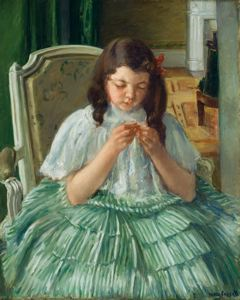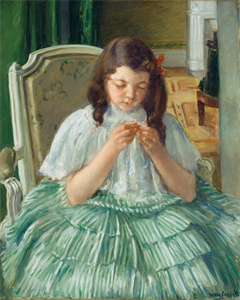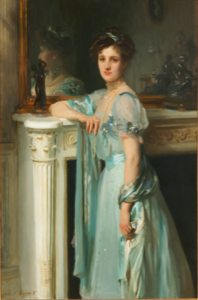
Mary Cassatt (aka Mary Stevenson Cassatt)
American, 1844–1926
"Francoise in Green, Sewing" dates from the final stage of Cassatt’s career. In her later paintings, Cassatt increasingly focused on depicting individual young children rather than women with babies. Earlier in her career, her single portraits of children were usually actual portraits of family members, specifically her nieces and nephews. At this stage, however, these children had grown, and she turned to young models such as Francoise, who was most likely from the nearby village of Mesnil-Theribus, Oise.
Among the distinctive features of Cassatt’s later works are changes in the manner of applying paint and the paint surface itself. The artist lavished care on the texture, color, and pattern of the voluminous blouse and skirt, conveying the character of the fabrics with quick strokes of a heavily loaded brush. She ties the painting’s foreground to the background by repeating the green of the skirt in the drapery behind the model. In making this costume such a defining element of the composition, Cassatt may have been inspired by her recollection of figure and history paintings by seventeenth-century artists such as Velasquez and Rubens in which setting and costume play an important role.
American, 1844–1926
Francoise in Green, Sewing
1908–1909
Object Type:
Painting
Creation Place:
Northern Europe, French
Dimensions:
32 in. x 25 3/4 in. (81.28 cm x 65.41 cm)
Medium and Support:
Oil on canvas
Accession Number:
2009.0006
Credit Line:
Gift of the Ida Belle Young Art Acquisition Fund
Currently On View
"Francoise in Green, Sewing" dates from the final stage of Cassatt’s career. In her later paintings, Cassatt increasingly focused on depicting individual young children rather than women with babies. Earlier in her career, her single portraits of children were usually actual portraits of family members, specifically her nieces and nephews. At this stage, however, these children had grown, and she turned to young models such as Francoise, who was most likely from the nearby village of Mesnil-Theribus, Oise.
Among the distinctive features of Cassatt’s later works are changes in the manner of applying paint and the paint surface itself. The artist lavished care on the texture, color, and pattern of the voluminous blouse and skirt, conveying the character of the fabrics with quick strokes of a heavily loaded brush. She ties the painting’s foreground to the background by repeating the green of the skirt in the drapery behind the model. In making this costume such a defining element of the composition, Cassatt may have been inspired by her recollection of figure and history paintings by seventeenth-century artists such as Velasquez and Rubens in which setting and costume play an important role.
Keywords
Click a term to view the records with the same keyword
Portfolio List
Click a portfolio name to view all the objects in that portfolio
This object is a member of the following portfolios:
Your current search criteria is: All Object records and [Object]Century is "Twentieth century" and [Object]Nationality is "French".

 by Artist (13)
by Artist (13)

